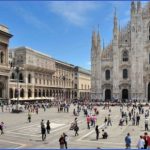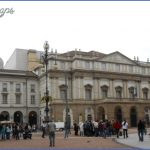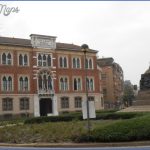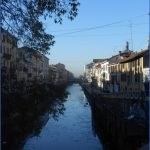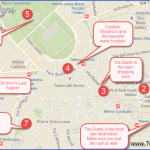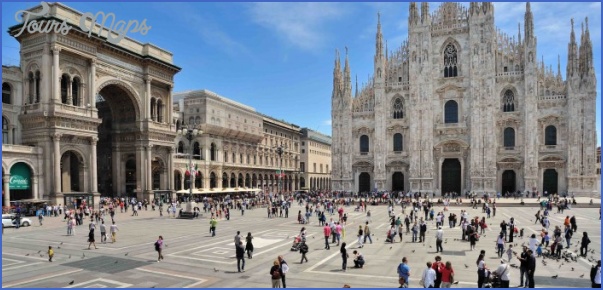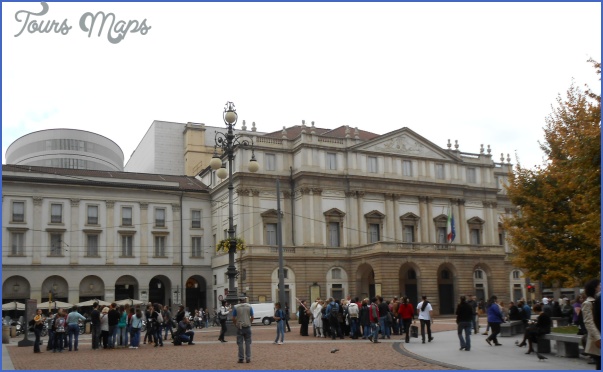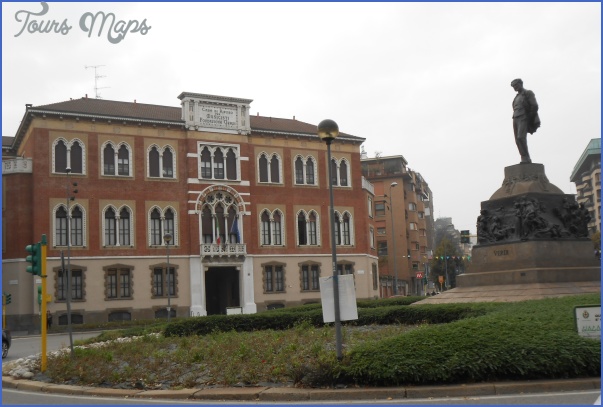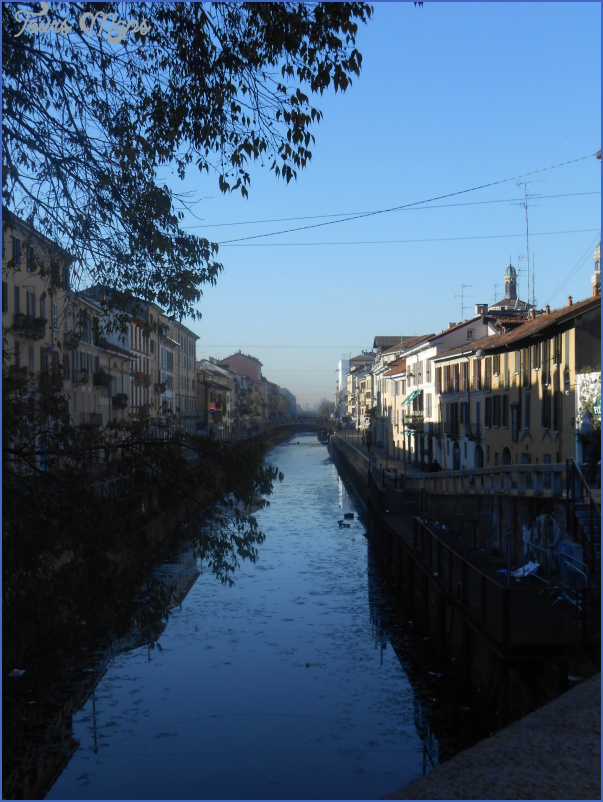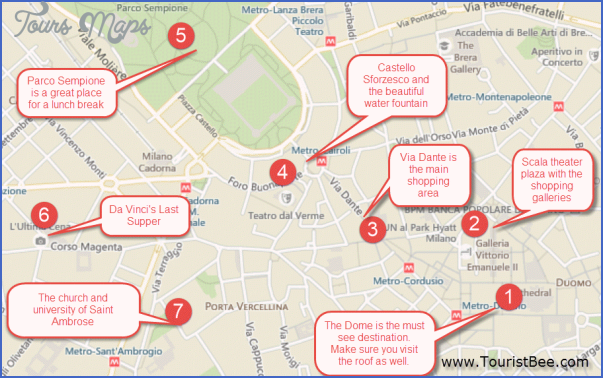Milan Guide for Tourist
NEAR CASTELLO SFORZESCO
CASTELLO SFORZESCO. Restored after heavy bomb damage in 1943, the Cas- tello Sforzesco is one of Milan’s best-known monuments. Constructed in 1368 as a defense against Venice, it was used as an army barrack, a horse stall, and a storage house before da Vinci converted it into a studio. Inside are the Musei Civici (Civic Museums), which include the Museo Degli Instrument! Musicali (Musical Instruments Museum) and the Museo d’Arte Applicata (Applied Arts Museum). The ground floor contains a sculpture collection most renowned for Michelangelo’s unfinished, angular Pieta Rondanini (1564), his last work. The Applied Arts Museum showcases ornate household furnishings and stars the Automa contesta di demonio. Play puppeteer to the red-eyed wooden demon by cranking the lever below. The underground level has several jeweled mummy cases among a small Egyptian collection. (MM1: Cairoii. Open Tu-Su 9:30am-7:30pm. Free.)
PINACOTECA DI BRERA. The Brera Art Gallery presents a superb collection of 14th- to 20th-century paintings, with an emphasis on the Lombard School. Works include Bellini’s Pieta, Hayez’s The Kiss, Andrea Mantegna’s brilliant Dead Christ, Raphael’s Marriage of the Virgin, Caravaggio’s Supper at Emmaus, and Piero della Francesca’s 15th-century Sacra Conversazione. (V. Brera 280. MM2: Lanza. Wheelchair accessible. Open Su and Tu-Sa 8:30am-7:15pm. ‚6.20.)
STADIO GIUSEPPE MEAZZA. Nothing in Milan comes close to the rivalry between its two soccer clubs, Inter and A.C. As passions roil, the city reaches a feverish pitch heightened by political overtones: Inter fans are often left-wing, while AC. fans tend to be right-wing. The face-off takes place in their shared three-tiered stadium (capacity 85,700), architecturally distinct for its spiralling ramps around the outside. Victory celebrations spill into the streets afterward, marred by occasional bursts of violence. An English-language tour leads through VIP seats, a museum of memorabilia, and the locker rooms. (MM2: Lotto. Tours M-Sa 10am-6pm. ‚10, under-18 or over-65 ‚7. Tickets for either team are available at all Ticket One offices; call s 02 39 22 61 for locations.)
CHIESA DI SANTA MARIA DELLA GRAZIE. The church’s Gothic nave is dark and elaborately patterned with frescoes, contrasting the splendid, airy Renaissance tribune Bramante added in 1492. The extensive interior renovations allow for a before and after view of the frescoes. Next to the church entrance, in what was once the dining hall, is the Cenacolo Vinciano (Vinciano Refectory), home to one of the most important pieces of art in the world: Leonardo da Vinci’s Last Supper. The painting captures the apostles’ reaction to Jesus’ prophecy: One of you will betray me. Make reservations well in advance or risk missing it. (P. di S. Maria delle Grazie 2, on C. Magenta, offV. Carducci. MM1: Cadoma Cairoii. s02 89 42 11 46. Open Su and Tu-F8am-7:30pm, Sa 8am-llpm. Entrance to Last Supper‚6.50.)
MUSEO NAZIONALE DELLA SCIENZA E DELLA TECNICA “DA VINCI. The brilliance and visionary impact of da Vinci, the first true Renaissance man, in all things technical serves as an ideological foundation for this museum. Tracing innovation from his day through the present, the museum provides a historical view of the precursors of modem technology. The hall of computer technology features an interesting hybrid: A piano converted to a typewriter by Edoardo Hughes of Turin in 1885. The keys have letters pasted to them, and a ribbon receives the letters from a spinning wheel. Another section focuses on applied physics, while wooden models of Leonardo’s most visionary inventions fill another room. (V. San Vittore 21, off V. Carducci. MM2: San Ambrogio. Open Tu-F 9:30am- 4:50pm, Sa-Su 9:30am-6:20pm. ‚6.20.)
BASILICA DI SANT’AMBROGIO. A prototype for Lombard-Romanesque churches throughout Italy, Sant’Ambrogio is the most influential medieval building in Milan. Ninth-century reliefs in brilliant silver and gold decorate the high altar. St. Ambrose presided over this building between AD 379 and 386. Now visitors may preside over him: Go behind the altar, on either side, and descend into a dim sarcophagus, where the skeletal remains of the saint rest beside those of his eternal bedmate, St. Protasio. The two asymmetrical bell- towers to the right and left of the facade are not miscalculations, but remains of an 8th century dispute between a group of Benedictine monks and the priests of the church. To make their case, the monks built the belltower on the right. The priests quickly followed up with their own version on the left. The bell- ringing competition that ensued forced the archbishop to arbitrate over who should ring the bell at what time and for how long. The 4th-century Cappella di San Vittore In Ciel D’oro, with exquisite 5th-century mosaics adorning its cupola, lies through the 7th chapel on the right; enter and then turn left. (MMl: San Ambrogio. Walk up V. G. Carducci, and the church bulwark rises up to the right. Open M-Sa 7:30am-noon and 2:30-7pm, Su 3-7pm. Free. Audio guide ‚1.)
NAVIGLI DISTRICT. The Navigali district, often called the Venice of Lombardy, the Navigli district comes alive at night. Complete with canals, small footbridges, open-air markets, cafes, alleys, and trolleys, the Navigli are part of a medieval canal system (da Vinci designed the original locks) that transported thousands of tons of marble to build the duomo and linked Milan to various northern cities and lakes. (Outside the MM2: Porta Genova station, through the Arco di Porta Ticinese.
BASILICA DI SANT’EUSTORGIO. Founded in the 4th century to house the bones of the Magi, the church lost its original function when the dead wise men were spirited off to Cologne in 1164. The present building, erected in 1278, dons a Lom-bard-Gothic interior of brick ribs, low vaults, and substantial columns. The aesthetic pinnacle of the church, and one of the great masterpieces of early Renaissance art, is the Portinari Chapel (1468), attributed to Michelozzo. It holds the Gothic tomb of St. Eustorgious (1339), whose ornate casket rests upon the white marble shoulders of the statues of 8 devotees one of whom has three faces. Near the front of the church is the 12th-century Porta Ticinese. (P.S. Eustorigio 3, down C. Ticinese from S. Lorenzo Maggiore. Tram #3. Open Su-M and W-Sa 9:30am-noon and 3:30-6pm. Cappella open Su and Tu-Sa 4:30-6:30pm.)
CHIESA DI SAN LORENZO MAGGIORE. The oldest church in Milan, San Lorenzo Maggiore testifies to the city’s 4th-century greatness. To its right lies the Cappella di Sant’Aquilino, which contains a 5th-century mosaic of a beardless Christ among his apostles. (On C. Ticinese. MM2: Porta Genova, then tram #3 from V. Torino. Open daily 7:30am-6:45pm. Cappella ‚2. Students ‚1.)
GALLERIA D’ARTE MODERNA. Napoleon lived here with Josephine when Milan was the capital of the Napoleonic Kingdom of Italy (1805-1814). The gallery, reminiscent of Versailles, displays modem Lombardian art as well as works by Impres-sionists. Of special note are Modigliani’s Beatrice Hastings (1915), Picasso’s Testa, Klee’s Wald Bau, and Morandi’s Natura Morta con Bottiglia. (V. Palestro 16, in the Villa Reale. MM 12: Palestro. Open Su and Tu-Sa 9am-5:30pm. Free.) Nearby is the Padiglione D’Arte Contemporanea (PAC), an extravaganza of video, photographs, multimedia, and painting. (Across P. Cardoma to Paleocapa, which becomes V. Alemagna. Ml: Cardoma. Wheelchair accessible. Open Su-W and F 9:30am-6pm, Th 9:30am-7pm. ‚8.)
MUSEO CIVICO 01 STORIA NATURALE. Milan’s Museum of Natural History holds extensive geological and paleontological collections, including fossils, minerals, and geological and botanical specimen. Though overshadowed by Milan’s other attractions, it is a pleasant destination for someone with extra time or interest in the subject. (C. Venezia 55. Open M-F 9am-6pm, Sa-Su 9:30anr6pm.)
Milan Guide for Tourist Photo Gallery
Maybe You Like Them Too
- Explore the Beautiful Town of Saint-Alban, France with This Map
- Explore the Beautiful City of Southport, Australia with This Map
- Explore Sasbach, Germany with our Interactive Map
- Explore Nevestino, Bulgaria with this Detailed Map
- Explore Pulau Sebang Malaysia with this Detailed Map

